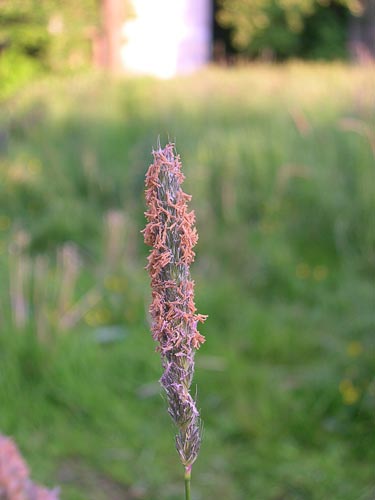Relatives
Alopecurus pratensis L. - Foxtail meadow.
Systematic position.
Family Poaceae Barnhart Genera Agrostis L.Synonyms.
A. alpinus Smith. songaricus Schrenk, A. laxiflorus Ovcz., A. seravschanicus Ovcz., A. songaricus (Schrenk) V. Petrov)Morphology and biology.
Perennial, short rhizomatous grass. Height, 50 to 150 cm. Stem is erect, with numerous leaves, numerous adventitious shoots. Leaves are 3-10 mm wide, to 60 cm long, green, planar and rough. Inflorescence is 10 cm long and 15 mm wide, bright, and gray at the time of maturity. Spikelet is 4.5-7 mm in length. It has one flower, is planar, elliptic, and pubescent, with short thin awn. Glumes have sharp points, that don.t diverge to different sides, generally smooth, but sometimes pubescent along carina and nerves. Lower floral glume is sharp, wide lanceolate, awned, nude, with 3 thin nerves. Straight awns start from lower floral glumes. There is no upper floral glume. Anthers are 2-3 mm in length. Seeds and glumes dehisce after maturing. Mass of 1000 seeds is 0.8-1 g. Flowering - June -July, maturing - July - August. Cross-pollinated, wind-pollinated. Seed and vegetative reproduction. Chromosome number 2n=28,42.Distribution.
European part of Former Soviet Union; Caucasia (non mountain parts, and mountains in west and central part of Caucasia); Western Siberia, Eastern Siberia (except north part); Far East (adventitious); Middle Asia (semi-desert region, mountains); Scandinavia, Atlantic and Middle Europe, Mediterranean, Asia Minor, Iran, Mongolia, China; adventitious or introduced in several other countries.Ecology.
Hydromesophyte. Species occurs on flood plain meadows, wet forest meadows, along forest edge, sand and shingle shelves adjacent to stream, lake and pond banks. Prefers wet fertile loose loam soils, occurs on peaty soil; grows poorly in dry, acid, and saline soils. Species is frost resistant, and flood resistant.Economic value.
Forage, used for hay, sometimes for pasture. Grows back rapidly after intensive grazing; not resistant to lodging. It recovers quickly after grazing; gives early and high pay harvest. It is highly palatable to cattle.Reference Citations:
Cherepanov S.K. 1988. List of Vascular Plants of Russia (Plantae Vasculares Rossicae et Civitatum Collimitanearum (in limics USSR olim)). St. Petersburg: Mir I Semia. 990 pp. (In Russian)Gubanov I.A., Kiseleva K.V., Novikov V.S., Tychomirov V.N. 2002. Illustrated determinant of plants of Middle Russia. Moscow. V.1: 526. (In Russian)
Harkevich S.S., ed. 1982. Wild fodder grass of Far East. Moscow: Nauka. 240 pp. (In Russian)
Kovalevskaja S.S., ed. 1968. Conspect of Middle Asia Flora. Taschkent: Publishing House Acad. Sci. Uzbekistan SSR. V.1: 226. (In Russian)
Tzvelev N.N. 1976. Poaceae USSR. Leningrad: Nauka. 788 pp. (In Russian)


